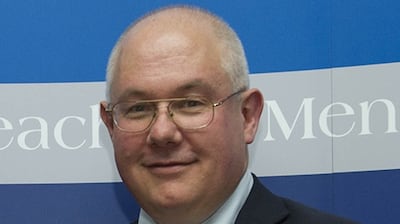When Prof Peter Kelly was a medical student there was a great sense of nihilism around the treatment of stroke as there was little or nothing that could be done for patients in terms of medical intervention.
However, since then there have been some major advances in the treatment of strokeand today, he and his colleagues are ensuring that Irish patients are some of the first in the world to access the most innovative new treatments available.
With stroke the third leading cause of death in Ireland (and second leading globally) and the leading cause of disability in this country, Prof Kelly, consultant neurologist and director of the stroke service at the Mater Hospital, says there is barely a family in the State that has not been touched by this disease.

“In human terms, it is an absolutely dreadful disease. Stroke is the appropriate name because it strikes like a thunderbolt. One minute you are well and the next minute you can be paralysed, or have have lost your speech, memory or sight. A stroke can rob somebody very quickly of their independence and autonomy. There is a huge cost to the individual patient at a human level, and to the health system, and a great deal more needs to be done around stroke,” he says.
Stroke is a disease that affects the arteries leading to and within the brain. A stroke occurs when a blood vessel that carries oxygen and nutrients to the brain is either blocked by a clot (ischemic stroke) or ruptures (haemorrhagic stroke), leading to the death of brain tissue and cells.
The first major development in stroke treatment came in the mid-1990s when it was found that if patients were given the clot-busting drug Alteplase quickly enough after having a stroke, some of the damage could be reversed and the patient’s chances of returning to full or near-full independence in a matter of weeks improved.
The second major development came when it was shown that organising the care of patients into stroke units clearly improved outcomes in the short and long term.
“A lot of us who had just begun our careers in the field were energised by these developments, and many of us decided to dedicate our careers to improving care for people with stroke,” says Prof Kelly.
Kelly heads up the Health Research Board (HRB) Stroke Clinical Trial Network Ireland which is made up of of eight Irish hospitals, six leading universities and all seven hospital groups.
In a major first for Ireland, the network is leading a new international clinical trial aiming to prevent secondary strokes and heart attack
The network has strong links with international researchers in the UK, Europe and North America, and in the past 18 months has joined several new international trials of new treatments for emergency care, prevention and recovery after stroke.
In a major first for Ireland, the network is leading a new international clinical trial aiming to prevent secondary strokes and heart attack after a first stroke. The Convince trial is investigating the potential of repurposing an anti-inflammatory that has been around for hundreds of years to treat gout and arthritis, and using it in low doses with standard treatments such as aspirin, statins and smoking cessation, to prevent recurrent stroke and heart attack in patients who survive a first stroke.
In recent years there has been much research interest in the role of inflammation in triggering heart attack and stroke. Prof Kelly explains that just as a pimple or boil can become red and inflamed, so too can the lining of the blood vessels. This inflammation can trigger the rupture of plaque and can lead to clots breaking off.
The Convince trial has started in Ireland and is being rolled out in nine other European countries. This research is of no interest to industry, as there is no profit in it, Prof Kelly says, but could be of major benefit to patients.
“A first stroke is an important risk factor for further strokes even if you are on the best treatment. Unfortunately, if you have a stroke, your risk of another in the first year afterwards is 6 per cent, which is far higher than the background population.
“That risk is cumulative over the next five years up to 15-25 per cent for a further stroke, heart attack or other vascular event. If you have a stroke, your risk of heart attack is higher and vice versa.”
While the HRB is the primary funder of the Stroke Network, the Irish Heart Foundation will fund new Stroke Research Nurses, and there is a very small amount (5 per cent) of funding from industry partners for education and training activities.
Prof Kelly says: “Irish patients will be some of the first in the world to have access to innovative new treatments which may provide us with evidence to change global guidelines and practice in stroke treatment.”
Atrial fibrillation
New global research suggests that up to one-third of strokes may be prevented with proper screening for the common heart condition asymptomatic atrial fibrillation (AF) in people aged 65 and older.

Dr Rónán Collins, director of stroke services at Tallaght Hospital, who was one of the key researchers involved in this study, points out that these findings have implications for stroke patients around the world.
Asymptomatic AF is the most common cause of heart rhythm disturbance and can be easily detected by simply taking the pulse, or by using handheld ECGs, which provide a diagnosis in less than a minute.
On the back of this research, the organisation AF-Screen has been established to push for the introduction of national screening programmes for this condition.
Dr Collins explains: “AF is an age-related condition that you are more likely to develop as you age. While younger people will usually have symptoms like palpitations or shortness of breath, in most older people AF is intermittent. The risk of stroke is five times greater if you have AF and very often the first time people know they have it is when they have a stroke.
“These strokes tend to be bigger, more severe, and more likely to be fatal – and, if you survive, are more likely to be disabling.”
The research group looked at people aged over 60 with a number of factors for stroke – including hypertension, diabetes and heart failure – and recorded their heart rate over five days. They found evidence of AF in more than 14 per cent of people living in the community with no awareness of their condition.
“This is clearly a big bang for your buck. You would not find a rate of 14 per cent through screening for breast or cervical cancer. It’s a very plausible target to look at a high-risk group for screening when stroke kills so many people.
“There is a whole range of simple lightweight wearable devices that measure your heart rate on the market now, and the technology is getting cheaper and easier to use,” Dr Collins says.
He is calling on the Department of Health to give AF screening the same funding and promotion as it gives to Breastcheck, given the serious personal consequences for the individual stroke sufferer and the massive financial cost of caring for stroke patients.
Halving stroke mortality
More and more Irish patients are now also availing of a ground-breaking new treatment that has been shown to reduce stroke mortality by half and to almost double the rate of positive life-changing outcomes for stroke victims. The thrombectomy procedure involves skilled neuroradiologists inserting an ultra-thin tube into the artery in the groin and up through the body into the brain vessels. The clot is then removed from the brain vessel by a retrievable stent, restoring blood flow to the brain.
This procedure is being performed at Beaumont Hospital, Dublin, the national centre for neurosurgery, and Cork University Hospital.
Dr John Thornton, consultant neuroradiologist at Beaumont, who has led the development of the thrombectomy service in Ireland, says the clot-busting medication used to treat stroke patients does not work for larger clots that typically result in the most severe strokes.
If a thrombectomy is carried out on time, and blood supply restored to the affected brain tissue, this tissue can actually recover.
“Every minute, two brain cells die once blood supply has been blocked off, so time is brain. Previously, stroke was regarded as a non-urgent scenario, as there was not much that could be done for patients, but now it’s one of the most urgent conditions on a par with acute heart attack and needs to be treated with the same urgency. Thrombectomy can be totally successful in some patients and can immediately and totally reverse the effects of a major stroke,” says Dr Thornton.
Some patients do not get any recovery when the clot is removed if too much brain tissue had died, while others may get only partial recovery or recovery may be slower, says Dr Thornton.
Without thrombectomy, these patients would receive the best medical treatment available, but many would be left permanently disabled.
The thrombectomy service was established at Beamount in 2010, and has grown rapidly since 2015, treating 170 patients in 2016 and an estimated 250 patients this year. The service at Beaumont is available 24/7 and treats patients from all over the country.
Dr Thornton points out: “The challenge is to get more rapid and efficient assessment and diagnosis of acute stroke patients who may be suitable for this procedure in more hospitals all over the country. The more efficient hospitals become at diagnosing acute stroke and doing CT scans, the more patients we will find within a suitable window for treatment.”
Stark statistics
The figures are stark. Stroke is the third-largest killer in Ireland and the most common cause of acquired, serious physical disability. Some 10,000 Irish people will have a stroke-related event this year, and a further 30,000 are living in the community with a disability as a result of stroke.

Prof Joe Harbison, head of the HSE's national stroke programme, has warned that Ireland's stroke services are heading for a crisis, and are unable to cope with the number of patients who need them now, never mind the predicted surge in cases as the population ages.
Since the creation of the national stroke programme in 2010, deaths from stroke have dropped by more than 15 per cent, while the number of those left with severe disability has fallen by more than 20 per cent. The emergency care for stroke patients provided in most Irish acute hospitals has improved significantly, and we are at the cutting edge of delivery of some new therapies such as thrombectomy.
However, the HSE’s National Stroke Audit 2016 showed that while the incidence of stroke is rising 4-5 per cent per year, we still have a severe shortage of stroke unit beds and specialist nursing, therapy and medical staff.
We have only about half the acute stroke unit beds we need to meet international standards and an even lower proportion of specialist rehabilitation beds. Stroke units have been shown to be twice as effective as coronary care units in reducing death and severe disability, but no hospital in the country has a unit that is resourced to minimum international standards.
And we still have only three small, under-resourced Early Supported Discharge teams for stroke which, Prof Harbison points out, are considered a basic element of care in most western European countries.
Harbison recently announced that the outcomes for stroke patients were in decline, reversing the major improvements that had been made in their care in recent years. The average length of stay for stroke patients is increasing, and more patients are being discharged to nursing homes.
Dr Rónán Collins, head of stroke services at Tallaght Hospital, says it’s not fair to be too nihilistic, pointing to the huge progress that has been made by the stroke community – including nurses, clinicians and allied professionals – and the Irish Heart Foundation over the past decade.
“We have achieved an awful lot in the past 10 years: things are 10 times worse in the UK and equally bad in France. Now 90 per cent of our acute hospitals have a stroke unit, we have 24/7 thromboylsis to treat stroke patients and increasing availability of thrombectomy for those who need it. This is a huge sea change from 2005 when we had no acute stroke units and no thrombolysis.”
Dr Collins highlights the need to develop the thrombectomy centre at Beaumont Hospital further, to ensure the centre at Cork University Hospital is properly resourced and to open a centre on the western seaboard and the south side of Dublin within the next 10 years to cover the whole country properly.
“We need to future-proof services, there’s no point in just building what we need now. We need to tackle stroke on two fronts, through prevention in the first place and through faster access to diagnosis and treatment of stroke patients in our hospitals.” he says.


















